JavaScript is disabled for your browser. Some features of this site may not work without it.
Buscar en RiuNet
Listar
Mi cuenta
Estadísticas
Ayuda RiuNet
Admin. UPV
Propiedades físico-químicas de diferentes especies para su uso en el análisis del proceso de autoencendido en un motor
Mostrar el registro sencillo del ítem
Ficheros en el ítem
| dc.contributor.advisor | López Sánchez, José Javier
|
es_ES |
| dc.contributor.advisor | López Pintor, Darío
|
es_ES |
| dc.contributor.author | Vega Asensio, Álvaro
|
es_ES |
| dc.date.accessioned | 2017-07-20T07:38:20Z | |
| dc.date.available | 2017-07-20T07:38:20Z | |
| dc.date.created | 2017-06-23 | |
| dc.date.issued | 2017-07-20 | es_ES |
| dc.identifier.uri | http://hdl.handle.net/10251/85518 | |
| dc.description.abstract | The study of combustion processes has taken special importance last years. Within these processes we find the autoignition phenomenom, the understanding of which is key in the development of more efficient and eco-friendly combustion engines. Thus, not only experimental, but also theoretical and computational tool are used for its study. The work developed in the following document has as objective the set up of a large database that contains interesting thermodynamic, transport and autoignition properties of species and mixtures usually involved in the combustion process. Both thermodynamic and transport properties are calculated using atomic theory, whereas autoignition ones are estimated by using an already developed program. This large database allows the control of the autoignition phenomenom throughout an Electronic Control Unit of an engine. This work has been developed using MATLAB, creating an executable file that generates the mentioned database through some properties of distinct elements. Finally, the obtained data are validated using specific literature information, in order to check the validity of the database and the ignition delay predictor model. | es_ES |
| dc.description.abstract | Actualmente el proceso de combustión en los motores está cambiando muy sustancialmente, dándose escenarios de combustión a baja temperatura, donde las características de autoencendido son muy distintas a las habituales. Tanto en los motores de encendido por compresión como en los de encendido provocado es necesario conocer dicho proceso de autoencendido (para controlarlo, en el primer caso, y para evitarlo en el segundo). Para ello el CMT ha adquirido recientemente una máquina de compresión rápida, en la que se puede reproducir y estudiar este fenómeno. El trabajo consistirá en colaborar en la explotación de esta herramienta de laboratorio para la caracterización de combustibles representativos de los habitualmente usados en automoción. | es_ES |
| dc.format.extent | 108 | es_ES |
| dc.language | Español | es_ES |
| dc.publisher | Universitat Politècnica de València | es_ES |
| dc.rights | Reserva de todos los derechos | es_ES |
| dc.subject | Tiempo de retraso | es_ES |
| dc.subject | Ignition delay | es_ES |
| dc.subject | Physicochemical properties | es_ES |
| dc.subject | Propiedades físico-químicas | es_ES |
| dc.subject | Tiempo de encendido | es_ES |
| dc.subject.classification | MAQUINAS Y MOTORES TERMICOS | es_ES |
| dc.subject.other | Grado en Ingeniería Aeroespacial-Grau en Enginyeria Aeroespacial | es_ES |
| dc.title | Propiedades físico-químicas de diferentes especies para su uso en el análisis del proceso de autoencendido en un motor | es_ES |
| dc.type | Proyecto/Trabajo fin de carrera/grado | es_ES |
| dc.rights.accessRights | Abierto | es_ES |
| dc.contributor.affiliation | Universitat Politècnica de València. Escuela Técnica Superior de Ingeniería del Diseño - Escola Tècnica Superior d'Enginyeria del Disseny | es_ES |
| dc.contributor.affiliation | Universitat Politècnica de València. Departamento de Máquinas y Motores Térmicos - Departament de Màquines i Motors Tèrmics | es_ES |
| dc.description.bibliographicCitation | Vega Asensio, Á. (2017). Propiedades físico-químicas de diferentes especies para su uso en el análisis del proceso de autoencendido en un motor. Universitat Politècnica de València. http://hdl.handle.net/10251/85518 | es_ES |
| dc.description.accrualMethod | TFGM | es_ES |
| dc.relation.pasarela | TFGM\54501 | es_ES |
Este ítem aparece en la(s) siguiente(s) colección(ones)
-
ETSID - Trabajos académicos [8903]
Escuela Técnica Superior de Ingeniería del Diseño





![MS Powerpoint file [PP]](/themes/UPV/images/mspowerpoint.png)

